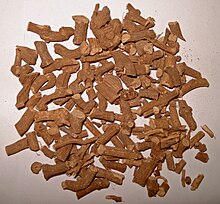| Long pepper | |
|---|---|

| |
| Long pepper's leaves and fruits | |
| Scientific classification | |
| Kingdom: | Plantae |
| Clade: | Tracheophytes |
| Clade: | Angiosperms |
| Clade: | Magnoliids |
| Order: | Piperales |
| Family: | Piperaceae |
| Genus: | Piper |
| Species: | P. longum |
| Binomial name | |
| Piper longum L. | |
Long pepper (Piper longum), sometimes called Indian long pepper or pippali, is a flowering vine in the family Piperaceae, cultivated for its fruit, which is usually dried and used as a spice and seasoning. Long pepper has a taste similar to, but sweeter and more pungent than, that of its close relative Piper nigrum – from which black, green and white pepper are obtained.
The fruit of the pepper consists of many minuscule fruits – each about the size of a poppy seed – embedded in the surface of a flower spike that closely resembles a hazel tree catkin. Like Piper nigrum, the fruits contain the compound piperine, which contributes to their pungency. Another species of long pepper, Piper retrofractum, is native to Java, Indonesia. The fruits of this plant are often confused with chili peppers, which belong to the genus Capsicum, originally from the Americas.
History

The oldest known reference to long pepper comes from ancient Indian textbooks of Ayurveda, where its medicinal and dietary uses are described in detail. It reached Greece in the sixth or fifth century BCE, though Hippocrates discussed it as a medicament rather than a spice. Among the Greeks and Romans and prior to the Columbian exchange, long pepper was an important and well-known spice.
The ancient history of long pepper is often interlinked with that of black pepper (Piper nigrum). Theophrastus distinguished the two in his work of botany. The Romans knew of both but their word for pepper usually meant black pepper. Pliny erroneously believed dried black pepper and long pepper came from the same plant.
Round, or black, pepper began to compete with long pepper in Europe from the twelfth century and had displaced it by the fourteenth. The quest for cheaper and more dependable sources of black pepper fueled the Age of Discovery.
After the discovery of the American continents and of chili pepper, called by the Spanish pimiento, employing their word for long pepper, the popularity of long pepper faded away. Chili peppers, some of which, when dried, are similar in shape and taste to long pepper, were easier to grow in a variety of locations more convenient to Europe. Today, long pepper is a rarity in general commerce.
Etymology
The word pepper itself is derived from the word for long pepper, Tamil word pippali. The plant itself is a native of India. The word pepper in bell pepper, referring to completely different plants under genus Capsicum, is of the same etymology. That usage began in the 16th century.
Usage


Though often used in medieval times in spice mixes like "strong powder", long pepper is today a very rare ingredient in European cuisines, but it can still be found in Indian and Nepalese vegetable pickles, some North African spice mixtures, and in Indonesian and Malaysian cooking. It is readily available at Indian grocery stores, where it is usually labeled pippali. Pippali is the main spice of nihari, a popular meat stew from India, originating in the Indian metropolis of Lucknow, and one of the national dishes of Pakistan.
See also
References
- ^ Toussaint-Samat, Maguelonne (2009) . The History of Food. Translated by Bell, Anthea (revised ed.). Blackwell. p. 491. ISBN 978-0631177418 – via Internet Archive.
- ^ Cobb, Matthew. "Black Pepper Consumption in the Roman Empire". Journal of the Economic and Social History of the Orient. 61 (4): 7–8. doi:10.1163/15685209-12341462. eISSN 1568-5209 – via University of Wales Trinity Saint David.
- Hyman, Philippe; Hyman, Mary (June 1980). "Connaissez-vous le poivre long?". L'Histoire. 24.
- Rawlinson, H. G. (2001) . Intercourse Between India and the Western World: From the Earliest Times of the Fall of Rome. Asian Educational Services. p. 14. ISBN 9788120615496 – via Google Books.
- Barnett, Lionel D. (1914). Antiquities of India: An Account of the History and Culture of Ancient Hindustan. Atlantic Publishers & Distributors. p. 14. ISBN 9788171564422 – via Internet Archive.
- "Pepper". Oxford English Dictionary. Vol. 7: N–Poy (1st (corrected re-issue) ed.). 1913. p. 663, definitions 1c, 2b.
- Kim, K. S.; Kim, J. A.; Eom, S. Y.; Lee, S. H.; Min, K. R.; Kim, Y. (February 2006). "Inhibitory effect of piperlonguminine on melanin production in melanoma B16 cell line by downregulation of tyrosinase expression". Pigment Cell Research. 19 (1): 90–8. doi:10.1111/j.1600-0749.2005.00281.x. PMID 16420250.
- Lee, W.; Yoo, H.; Kim, J. A.; Lee, S.; Jee, J. G.; Lee, M. Y.; Lee, Y. M.; Bae, J. S. (2013). "Barrier protective effects of piperlonguminine in LPS-induced inflammation in vitro and in vivo". Food and Chemical Toxicology. 58: 149–57. doi:10.1016/j.fct.2013.04.027. PMID 23619565.
| Taxon identifiers | |
|---|---|
| Piper longum |
|